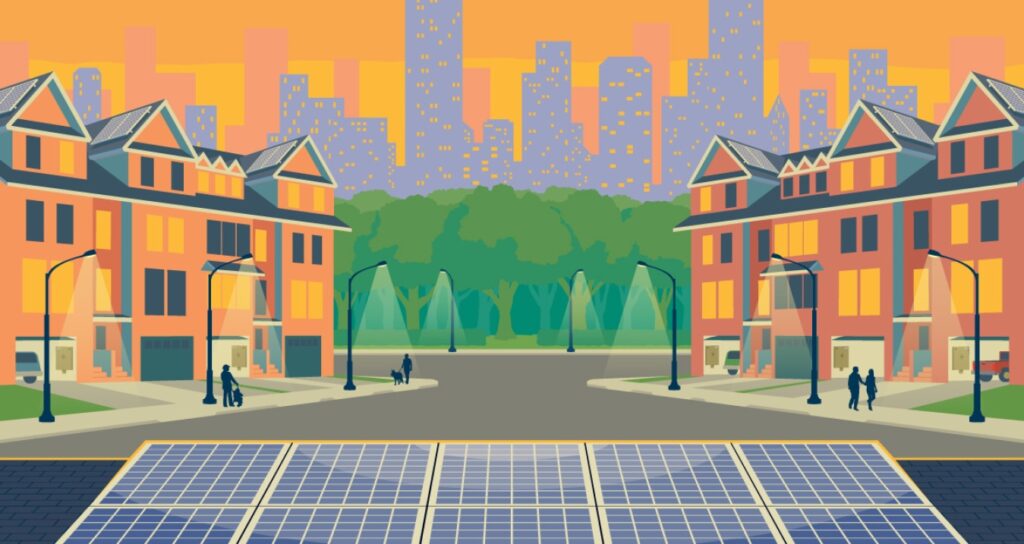Sign up for daily news updates from CleanTechnica on email. Or follow us on Google News!
Virtual power plants are spreading across the US, enabling more electricity ratepayers to save money on their utility bills while motivating a shift away from gas appliances. Apparently President Trump hasn’t figured out a way to squash them, but give him a chance. He’ll figure it out. In the meantime, an interesting twist has bubbled up in the form of a new grid concept that launches itself into defensive mode when danger threatens, fending off cyberattacks, natural disasters, and other potential disruptions.
Virtual Power Plants Are Coming For Your Fossil Fuels
Virtual power plants are designed to reduce, if not eliminate, the need to build new brick-and-mortar gas power plants for handling daily peak demand periods. In the virtual power plant model, utilities offer rate discounts that motivate individual ratepayers to shift their use of electric appliances and other equipment into off-peak hours.
Virtual power plants are becoming more sophisticated alongside new developments in connected technology. Virtual power plants can alert ratepayers to on-the-spot load shifting discounts, enabling grid managers to avoid brownouts, blackouts and other disruptions. Ratepayers with onsite battery energy storage can can also bank kilowatts for sale back to the grid, and those with solar panels can generate additional income.
New grid-edge technology is also coming into play. Grid-edge simply refers to HVAC systems, appliances, and other electrical equipment used by ratepayers. When connected to the Internet, grid-edge devices become part of the “Internet of Things,” capable of communicating remotely. Virtual power plant participants can use an app respond to load-shifting cues and other alerts on the go, rather than running home to adjust their appliances down.
Meet The Self-Defending Grid Of The Future
Into this picture steps a research team at MIT. They have developed a “local electricity market” grid emergency response concept that enables grid managers to communicate instantly with grid-edge devices including solar panels, batteries, electric vehicles, home appliances, and smart thermostats for HVAC systems in case of a cyberattack or other grid disruption.
A soon-to-be published study describes the system, which the MIT team calls EUREICA for Efficient, Ultra-REsilient, IoT-Coordinated Assets. MIT has also offered a plain-language rundown of how it works.
When a ratepayer opts into a local electricity market, the grid manager can quickly communicate with all of their connected grid-edge devices through an algorithm. In case of emergency, the algorithm searches for subscribers, identifies their devices, and determines which devices are best suited to prevent or mitigate an impending power failure, including those resulting from cyberattacks.
Depending on the situation, the algorithm can dial down demand from these devices, or it can pull stored energy from them. In return, the subscriber receives compensation for their contribution to the grid.
In tests of the system, the MIT team studied hypothetical power losses of 5-40%. “We assume some nodes are attacked, and some are still available and have some IoT resources, whether a battery with energy available or an EV or HVAC device that’s controllable,” explains MIT researcher Vineet Nair, co-author of the forthcoming study.
“So, our algorithm decides which of those houses can step in to either provide extra power generation to inject into the grid or reduce their demand to meet the shortfall,” Nair added.
Shoutout To The Building Electrification Movement
Both virtual power plants and the local electricity market concept dovetail with the building electrification movement. Whether by retrofit or new construction, ratepayers are reducing or eliminating their use of natural gas and other fossil fuels in favor of electric appliances and equipment.
“There are lots of distributed energy resources that are coming up now, closer to the customer rather than near large power plants, and it’s mainly because of individual efforts to decarbonize. So you have all this capability at the grid edge,” notes Nair.
Virtual power plants are here-and-now solutions that don’t necessarily rely on IoT devices. The EUREICA concept could be applied in the future, when more homes and other buildings sport connected devices.
“The team envisions that for a given region, such as a community of 1,000 homes, there exists a certain number of IoT devices that could potentially be enlisted in the region’s local network, or microgrid,” MIT explains.
In effect, EUREICA treats the local market as a microgrid. In addition to coordinating devices within one microgrid, grid managers can also coordinate nearby microgrids with each other.
The MIT team ran the system through several different grid risk scenarios including natural disasters and cyberattacks. For example, one test involved a cyberattack on smart thermostats, which could have overloaded the grid simply by simultaneously raising the temperature on individual devices.
“In every scenario that they tested, the team found that the algorithm was able to successfully restabilize the grid and mitigate the attack or power failure,” MIT concludes.
From Virtual Power Plants To Efficient, Ultra-REsilient, IoT-Coordinated Assets
Saturating the grid of the future with IoT devices is just the first step. Getting ratepayers to subscribe will be another challenge, assuming that the local electricity market concept passes muster with legislators and other elected officials.
That is quite a challenge, but the virtual power plant movement has already primed the pump for bidirectional ratepayer-grid collaboration, with a healthy assist from the US Department of Energy.
Whether or not the Energy Department continues to stimulate activity in the virtual power plant area remains to be seen, but at least they helped get the ball rolling.
It’s a pretty big ball. Utilities and policy makers are collaborating with other energy stakeholders to introduce more onsite solar and energy storage into their grids. One example is the forward-looking energy firm Sunnova Energy International, which has received Energy Department support for its VPP program.
Sunnova specializes in VPPs that enable solar and storage owners to sell their excess kilowatts back to the grid. In April of 2024, Sunnova announced new virtual power plant investments in California, Connecticut, Massachusetts, New York, Puerto Rico, Rhode Island, and Texas.
“We are revolutionizing the role of solar and storage while putting money back into our customers’ pockets – and the response has been overwhelming,” explained Sunnova CEO John Berger.
At the time, Sunnova counted more than 419,000 customers on its VPP roster, with a combined energy storage capacity estimated at 1 gigawatts. “Electricity demand is being driven to record levels and the power grid is not ready – but VPPs can offer critical help,” added Berger.
“We see VPPs as insurance for the grid, as they are ready now to provide power in times of need and tackle the impending challenges ahead of a constrained electric system,” he emphasized.
Texas is a particularly hot market for VPPs, so keep an eye out for activity there.
If you participate in a VPP, drop a note in the comment thread and share your experience. Better yet, tell your representatives in Congress.
Image: The virtual power plant movement has primed the pump for advanced grid management systems designed to prevent power disruptions (Courtesy of US Department of Energy).
Chip in a few dollars a month to help support independent cleantech coverage that helps to accelerate the cleantech revolution!
Have a tip for CleanTechnica? Want to advertise? Want to suggest a guest for our CleanTech Talk podcast? Contact us here.
Sign up for our daily newsletter for 15 new cleantech stories a day. Or sign up for our weekly one if daily is too frequent.
CleanTechnica uses affiliate links. See our policy here.
CleanTechnica’s Comment Policy

